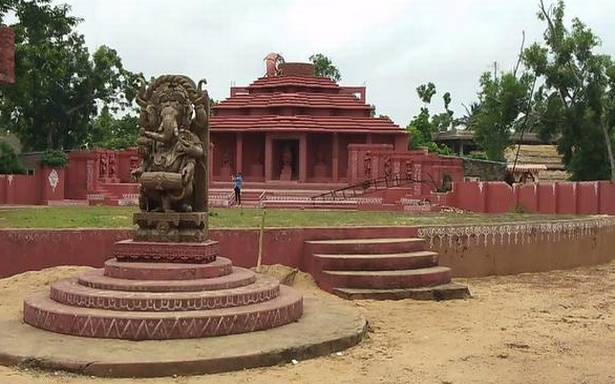Remembering Guru Gangadhar Pradhan, who dreamt of putting the small Odisha town on the cultural map
As we arrived at Konark Natya Mandap, the venue of the 35th annual Konark Dance and Music Festival in Odisha, held over the past fortnight, we found people pausing for a moment at the entrance to offer prayers at a memorial before taking their seats.
This memorial is dedicated to Guru Gangadhar Pradhan, who, for 25 years, used to stand with folded hands at this very entrance every day of the festival as he welcomed audience, artistes and guests.
Founder of the popular festival, which he curated, Guru Pradhan also established the Konark Natya Mandap.
“After his untimely death a decade ago, the festival continues to celebrate his vision and artistic values. Legendary artistes such as Ustad Amjad Ali Khan, Vyjayanthimala Bali, Ustad Zakir Hussain, Yamini Krishnamurthy, Pt. Hariprasad Chaurasia and Vikku Vinayakram, who have been the recipients of Guru Gangadhar Pradhan Lifetime Achievement Award, have supported and performed during the last 10 editions,” says Gurupada Baliarsingh, joint secretary, Konark Natya Mandap.
Barely two kilometres from the stunning Sun Temple stands the Konark Natya Mandap on some sand dunes nestled amidst casuarina groves. A replica of the Konark temple, it provides a perfect ambience for the dance and music festival that is held here every February.
In an earlier interaction, Guru Pradhan had told me, “When I started Konark Natya Mandap and the annual festival here, my objective was to promote and project the rich cultural heritage of my state to those visiting Konark and Puri from all over the world. I wanted to set up a gurukul to train youngsters.”
Not just an amazing guru and choreographer, he had a remarkable sense of visualisation too. The three-tier stage that can accommodate about 200 dancers at a time is proof of that. Guruji is said to have altered the design six times before arriving at the final one.
Son of a poor farmer, Gangadhar Pradhan was offered at the age of five to a village temple to serve as a Gotipua dancer. He stayed in the temple for 10 years. When he was 25, he established the globally renowned Orissa Dance Academy in Bhubaneshwar. And by the time he was 30, he had already acquired the land for his dream project, the Konark Natya Mandap.
His only precious possession then was a bicycle and he used to make a living by teaching dance and accompanying dancers on the mardal (percussion instrument).
“When we shifted from Bhubaneswar to Konark with our children, there was no habitation around this site. We put up a thatched hut on the small piece of land given by my mother and stayed in it. Guruji would hardly sleep or eat well those days. He would often wake up in the middle of the night and walk around immersed in his thoughts. It worried me; I did not know what was on his mind,” says Sulochana Pradhan, guruji’s wife.
Despite no financial backing and support, Gangadhar Pradhan did not give up his plan. Recalling the first festival, Guru Pradhan once said, “It is etched in my memory. It was on an open-air stage of brick and mud. The artistes found it extremely difficult to perform on it. But such was our spirit that the 10 dancers and seven singers, including Ileana Citaristi from Italy, and the small audience were oblivious to it all, being immersed in pride and delight.”
His close associates remember how late Odissi exponent Sanjukta Panigrahi asked him to cancel the festival the year his mother was diagnosed with cancer and use the money for her treatment, but guruji refused. He often skipped overseas tours for the festival, even though that resulted in monetary loss.
When he was appointed as a visiting faculty at Cornell University, U.S., he used the ₹12 lakh grant he received to buy land for the Natya Mandap rather than build himself a house.
A recipient of the Padma Shri, the Sangeet Natak Akademi award, an honorary doctorate from Utkal University, Odisha, and honorary citizenship from some countries, Guru Pradhan not just promoted classical dance but all genres of Indian art, especially the lesser known ones. .
“He was the first to offer a platform for Odisha’s indigenous percussion instrument mardal, which was till then seen only as an accompanying instrument for Odissi,” says noted mardal exponent Guru Dhaneswar Swain. Similarly, he was also the first to introduce Assam’s Sattriya dance to Odisha through his festival.
Like the arts, his audiences were treated equally. At the festival, there were no reserved seats, and villagers and invited guests all sat next to each other. The famous community dinner he organised during the festival saw audiences and artistes sitting on the floor to eat the Odia food served on banana leaves by the villagers, who also worked as volunteers at the festival.
It was the spectacular success of Guru Gangadhar’s Konark festival that prompted the Odisha Government to launch its own famed flagship festival, the Konark Utsav.
“A day should not pass without a performance happening at Konark Natya Mandap,” Guru Gangadhar had told his disciples. And they have kept it going. Music and dance are the daily offerings to the presiding deity, Lord Balunkeswara.
The day he passed away, the Gotipuas performed his favourite composition, ‘Ame Odiare Ame Odia’ (We, the Odias) at the Mandap’s entrance.
As we left the venue this year, we felt Guru Pradhan’s presence. He lives on through every performance staged here.
The author is a
Bhubaneswar-based journalist, who writes on culture.
Source: Read Full Article

